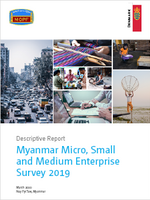Filter by...
Reset all
Publications (29)

Many displaced people around the world are in limbo—unable to return home or go anywhere else. Our surveys show that displaced people have lived in their current location for 6.9 years on average, significantly longer than the five-year threshold for what is typically considered a ‘protracted’...
Journal Article
This peer-reviewed research is available free of charge. UNU-WIDER believes that research is a global public good and supports Open Access.
Part of Journal Special Issue
What sustains informality
Journal Article
This peer-reviewed research is available free of charge. UNU-WIDER believes that research is a global public good and supports Open Access.
In many low-income transition countries, where formal institutions such as courts do not function effectively, informal institutions are often used by firms to minimize transaction risks. We examine the role of informal institutions, in the forms of relational contracting and social networks, in...
Journal Article
This peer-reviewed research is available free of charge. UNU-WIDER believes that research is a global public good and supports Open Access.
Using a survey of enterprises in Myanmar, we examine demand for formal credit and the extent to which firms are self-constrained by not applying for credit or if they apply and are constrained by bank’s rejections. We have information about firm managers’ managerial capacity and risk attitude. We...
Working Paper
pdf
– Application of a new computable general equilibrium (CGE) model
Myanmar is facing climate change (CC) induced changes to the productivity of their critically important rice sector over the coming century. Moreover, the recent five-year Myanmarese Agriculture Development Strategy (ADS) sets out a vision of achieving an ‘…inclusive, competitive, food and nutrition...
Working Paper
pdf
– Application of a new computable general equilibrium (CGE) model
Myanmar has, in recent years, strengthened its focus on human capital as a development pillar, and introduced legislation and adopted conventions on child labour. But child exploitation continues, including use of forced labour by the military and children performing hazardous work. Moreover...
Working Paper
pdf
– Application of a new computable general equilibrium (CGE) model
Despite major public finance reform efforts over the last decade, Myanmarese public finances continue to be characterized by relative weakness in revenue collection, budget execution, and long-term sustainability. Myanmar is therefore in need of comprehensive public finance reform. Two top...
Working Paper
pdf
– Evidence from matched employer–employee data
The quality of people’s jobs is a fundamental determinant of their well-being, and judging the state of a labour market on the basis of job quantity alone delivers a very partial picture. This study is an attempt to place the spotlight on the working conditions of workers in the Myanmar...

– Descriptive Report
Myanmar’s manufacturing sector is at the heart of the country’s commercial landscape. From garment production for the international market to diverse food, furniture, gemstones, and metal provision, the more than 70,000 micro, small, and medium firms, employing hundreds of thousands of people...
Working Paper
pdf
Myanmar’s economy has experienced political and economic transformations since 2011 by means of diverse economic reforms. However, the power sector is still struggling to fulfil electricity demand. This study will examine aspects of the electricity sector in an economy-wide perspective by means of...
Working Paper
pdf
– Evidence from two matched employer–employee surveys
We look into the relationship between business practices and enterprise productivity using panel data with matched employer and employee information from Myanmar. The data show that micro, small, and medium-size enterprises in Myanmar typically do only a few modern business practices.Even so...
Working Paper
pdf
Employer-provided benefits are independent elements in the compensation packages that make up firms’ payment strategies. Such benefits are aimed at attracting and retaining preferred employees and improving incentives. In Myanmar, there are two employee benefit systems: (1) an unregulated...
Working Paper
pdf
Using a novel panel survey of enterprises in Myanmar, we compare the performance of manufacturing firms by three different informality definitions. The first is binary, based on whether firms pay taxes. The second captures five categories of registration with the authorities, and the third...
Working Paper
pdf
– A multiplier decomposition analysis for Myanmar
This paper considers the impacts of agro-industry development and international trade on income distribution in Myanmar, focusing on low-income rural households. We use a social accounting matrix multiplier (SAM) decomposition model featuring detailed economic linkages. After describing the Myanmar...

– Descriptive Report
The 2019 descriptive report of the Myanmar Micro, Small, and Medium Enterprise Survey is the second quantitative report of the Myanmar Enterprises Monitoring System (MEMS) project. MEMS is a four-year project, and is implemented by the Central Statistical Organisation under the Ministry of Planning...
Working Paper
pdf
Based on a recently constructed 2017 Social Accounting Matrix, we examine structural aspects of the Myanmar economy. The exposition ranges from industry, trade, household income, and expenditure to labour market issues. Agriculture remains dominant, accounting for about 50 per cent of employment...
Displaying 16 of 29 results
 Join the network
Join the network